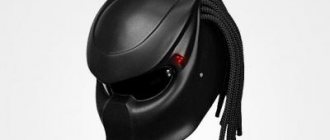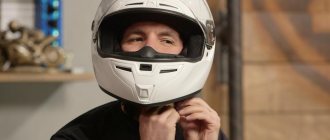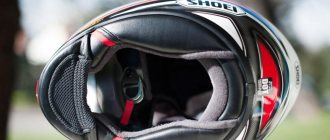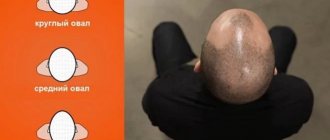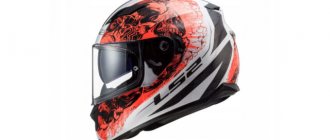Motorcyclists have an extremely difficult time on the roads; they are not noticed by car drivers; constant risks simply accompany every motorcyclist. Therefore, today we will look at the Predator motorcycle helmet, which is distinguished by its reliability and allows you to scare other road users.
Therefore, you need to seriously think about safety, we have already talked about such a necessary thing as a motor turtle, now it’s time to talk about the right helmet. Safety should be paramount, especially since even with a helmet and equipment, the life of a motorcyclist is in the balance every time, especially if he flies in the oncoming speed of 250 km/h, but this biker with the video says that he did not ride more than 190 km/h , by the way, here’s a video about how to ride a Yamaha P1:
The choice of helmets is extremely large, but every self-respecting biker wants to somehow stand out and have his equipment and motorcycle checked out by other bikers at conventions. By the way, the Predator motorcycle helmet is a helmet from the domestic manufacturer NLO Moto from Moscow, and there is also a company in Tolyatti - Nitrinos. Each manufacturer has its own helmet structure, so they may differ and have their own characteristics. The Predator helmet is popular here and abroad.
Buy by size!
Choosing the wrong equipment reduces all equipment protection to zero.
An example that is too loose provides proper fixation and can shift position upon impact. Too narrow - it is inconvenient and will press. The first step is to measure your head circumference above the ear with a measuring tape. Every more or less well-known manufacturer of motorcycle helmets has a sizing table. Note: the values in the table are different for each company; they do not coincide.
for example, the dimensional grid of the icon company:
Don't rush to go to the checkout and pay for your purchase. Calmly put on a motorcycle helmet and stay in it for 5-10 minutes, turn your head, tilt it in different directions, up and down. Jump on the spot several times to make sure that the purchase does not fly off or change position. It should not press hard or cause pain; the inner lining should gently fit the face. See if the view is wide and if objects from the side are clearly visible. When choosing between two pieces of different sizes, take the smaller one.
Which size should I choose?
This is a very popular dilemma. Many people buy their first helmet too big, even though at the time of purchase they think they got the right one. The helmet should be very tight on the head. The cheeks may even be clenched so that it is difficult to close the mouth. Over time, the cheek lips will improve. Initial setup usually takes several tens of hours. The situation is different with the circumference of the helmet near the forehead. If you have a severe headache, this is a bad sign. If it doesn't stick well to your forehead, that's also bad. The lining of the new helmets is very pushing, so when trying, I suggest you check if you can put your finger between your forehead and the helmet.
If so, you need a smaller size. Unfortunately, it may happen that the model does not suit you - L will be too large and M will be too small. Then all that remains is to choose another helmet. Remember that each model will fit differently on your head. Even different models from the same manufacturer will vary!
Some manufacturers offer the option to purchase cheek sponges in a different size than standard ones. This means that, for example, when you buy a size M helmet, you can put an XL size sponge in it. This particularly applies to those more expensive helmets. Then the risk of mismatching the required size will be much less.
Shuei helmet
However, size isn't everything. Due to differences in shell shape, one helmet will be more comfortable for you than another. There are people for whom choosing a helmet is quite difficult. This is why buying online without trying it on is a VERY bad idea.
Each manufacturer provides a size chart. So you can suggest the head circumference and choose the size according to it, but this is not a good idea. For example – depending on the size, I should ride in size S helmets, but 90% of the helmets that fit me are XS, and there have been cases where even that size was too big. This doesn't mean, however, that everyone should buy helmets smaller than the scoop size - it's just that with my head it's true, with yours it's the opposite.
Varieties of the Predator helmet
The basis for the “Predator” line of motorcycle helmets from the Nitrinos studio is its basic version, which is characterized by the following indicators:
- Sizes: XS 53-54 cm.
- S 55-56 cm.
- M 57-58 cm.
- L 59-60 cm.
- XL 61-62 cm.
- XXL 63-64 cm.
- Color: matte black.
- Visor: light.
- Dreadlocks: 22 pcs., length 34 cm.
- Weight: 1820 g
The basic version can be given an almost unique look with the help of additional upgrades.
Additional options include:
- LED module. It consists of three red LEDs built into the helmet body on the right side. Switching on is done by a button located at the bottom of the helmet. Connects to two AAA batteries.
- Laser module. It consists of three red lasers in a single housing, built into the helmet body on the right side. Switching on is done by a button located at the bottom of the helmet. Powered by two AAA batteries.
- Painting with one color. Additionally, the motorcycle helmet is painted in any color at the request of the customer.
- Additional dark visor. In addition to the light one, you can order a replaceable dark visor for sun protection.
- Additional mirror visor. In addition to the light visor, you can order an interchangeable mirror visor to change the style of the helmet.
- Tips for dreadlocks made of carbon.
- Kevlar dreadlock tips. Available in three colors - red, orange and blue.
- Engraving. The external design of the helmet can be complemented by engraving of scars, hieroglyphs, painted in red or silver paint. In addition, the motorcycle studio can produce engravings according to customer sketches.
- Carbon version of the helmet. Additionally, the helmet can be covered with a layer of carbon fiber followed by the application of colorless varnish, which significantly changes the appearance of the helmet.
- Airbrush. Produced manually by motorcycle studio specialists. Several design options are offered. Design according to the customer’s individual sketch is possible.
- Volumetric fangs. Two versions of the plastic fangs are glued onto the bottom of the helmet, adding to the overall design of the helmet.
- Carbon version of the helmet with carbon fangs.
In turn, it offers several models of Predator helmets:
- Berserker Predator. The basis of the helmet is the HJC motorcycle helmet. The helmet has a visor that can be opened with one hand, 17 dreadlocks made of foam rubber, and a double casing with an additional damping layer. The helmet weighs 2.2 kilograms.
- Predator 3; The basis of the helmet is a Nolan motorcycle helmet. The helmet has a one-handed visor, 20 nylon dreadlocks, a double fiberglass shell and carbon reinforcement. The helmet weighs 2.1 kilograms.
- Predator 4. Restyling of the Predator 3 model. Parameters and characteristics are saved. Changes affected the external design of the helmet.
Thus, models differ from each other in the model of the base helmet, color scheme, number and length of dreadlocks (cords hung on the back of the helmet) and cost. A special feature of helmets from the NLO-MOTO studio is the easily opening visor, which when opened plunges into the body of the helmet.
Neko helmet or helmet with ears like a cat's
Probably the most popular model is the Neko helmet or helmet with cat ears . It produces a simply amazing effect on those around you, you just have to put it on and everyone will want to take a photo with you, and if you are also a girl, then it will be very difficult to fight off fans.
The model is based on a time-tested, modern and comfortable IXS-1000 helmet.
Although the main feature of Nitrinos helmets is design, the company nevertheless pays a lot of attention to the quality of its products. For example, in the Neko model, in the event of an accident, the additional ears simply break and do not cause any harm to the motorcyclist. These lugs also have through holes which make them very aerodynamic.
The basic model of a neko-helmet will cost about $160, for this money you will get a black or white helmet with ears.
It is also possible to create your own unique helmet using additional options:
- By adding another $30 to the initial amount you can get a two-color helmet
- If you pay an additional $45, the artist will make a sketch of a three-color helmet that will ideally match almost any equipment.
- Well, if you can afford to add another $70 to the base price, you will receive an individual designer neko-helmet with airbrushing.
Choosing a motorcycle helmet
Despite the fact that motorcycle helmets have a size classification, you should not rely on it too much. Different manufacturers may use their own sizing system based on numeric or alphabetic characters, in inches or metric units.
Of course, it’s better to measure your head circumference again before going to the store - this will help with your initial choice. But trying on a motorcycle helmet remains a prerequisite when purchasing it.
- The helmet should fit fairly easily, from top to bottom.
It should sit tightly on your head, but without squeezing it. There should be no gaps between the frontal and temporal parts of the helmet and the head (the thumb should not go through).
Having put it on completely and having secured the chin strap (if equipped), you must try to move the helmet with your hands, shake your head in different directions - a well-fitted product should not move. The belt should not be too tight; it must be adjustable and the buckles can be easily unfastened.
If the helmet has a neck protector at the back, it should not move when you tilt your head back.
During fitting, you should walk around in the helmet for less than 5 minutes to make sure it fits your head comfortably. Perhaps the first feeling that the helmet is too small will pass - the elastic comfort layer will adapt to the required configuration. After removing the helmet, you should make sure that there are no pronounced areas of increased friction between the skin and the inner lining (cheek area, ears, neck).
Be sure to ensure good visibility of the helmet and visor in all directions. Motorcyclists who regularly use glasses should make sure that the design of the product allows them to be worn.
When choosing a helmet, you should definitely pay attention to the integrity of its outer layer - there should be no signs of impacts, scratches, chips, etc. on it. In addition, a high-quality helmet is a design thought out to the smallest detail, which does not tolerate any independent “improvements.”
You should never, under any circumstances, purchase a used helmet, no matter how “cool” and “sophisticated” it is presented.
And one last thing. Any helmet has a certain service life, even if it has not been subjected to significant mechanical stress. Manufacturers of even the highest quality models recommend changing it at least once every 4 years. For helmets made of molded thermoplastic, this period is even shorter - up to two years.
The helmet retains its protective qualities until the first serious impact, and if this happens (even not in the event of an accident, but simply when falling from a height), it must be immediately replaced.
Hello friends!
So, this time I set out to make a predator's head. And he did make it. Yes, the result turned out to be not the same as that of the local craftsmen. By the way, I take this opportunity to say hello and thank them for the step-by-step description of the process of creating this kind of thing. My entire skull helmet is covered in bumps, some potholes and scratches. And this head weighs so much that my neck will soon become as pumped up and thick as that of mixed-fight fighters. And it's all about crookedness. Okay, from afar all this bacchanalia will be invisible.
Surely, if the Predator society had adopted the same rules as we had in ancient Sparta, when crippled newborns were thrown off a cliff or fed to pigs, then a predator cub with a head similar to my creation would instantly fly into the abyss of outer space.
But I do not despair, because the end of a thing is better than the beginning. Next time it will be better.
It turns out I had a helmet for number two. Honestly, I have never seen anything worse. However, it was a real Buddhist Chinese helmet for 700 Russian tenge. Yes, I know that by forcing him to put on his passenger, he did not gain any protection. Unless from the traffic police.
But I honestly went around all the stores in my city for 100k and in the neighboring one for 600k, trying to find a branded helmet. There’s nothing there... Okay, then I tried to find a Chinese one, but at least it would fit. And then nothing. A helmet either the size of an airship, in which my head dangled like a ping-pong ball in the gym, or a helmet for gnomes, hobbits, tadpoles, microcephalics.
Still, I took it the size of an airship, deciding that I would stuff it with foam rubber. I stuffed it up and it became noticeably better. The visor of this helmet is scratched by anything harder than a fingernail. It is also cloudy and with its curvature distorts this beautiful and crazy world. The inside of the helmet smells like the smell of the fuel and lubricants warehouse when I served in the army.
My brother, and then my girlfriend, rode in this helmet for a season, and even in such a short time, the visor was completely covered with scratches, not only on the outside, but also on the inside. And I told her that such long eyelashes are too much. Well, I took off the visor, put a hairy grinding wheel on the grinder and began to process it. It has become noticeably better.
Encouraged by the success, I thought that it wouldn’t matter if everyone could see my eyes in the helmet, so the visor should be tinted. Actually, I did this in order to feel somehow more protected from the mocking glances of passers-by. And according to the canon, the visor of a predator should be black.
I trudged to the auto store and stocked up on tint film with 90% light transmittance. Here are our proud traffic police officers who find fault with the tinting on the windshield of a car. I wonder if they picked on anyone for having a tinted visor?
Okay, first of all, I spent five minutes peeling off the protective film of the tint to expose the sticky layer. They used: nails, brother’s teeth, knife, needle, scalpel, blade. I even tried to use two strips of tape, gluing them to different sides of the film. Somehow I peeled off the film and began to stick this thing on the visor. Oh, how great and powerful the Russian language is when it comes to swearing. Oh those bubbles! I hate it!
Then, remembering my experience in gluing photoresist onto the surface of a printed circuit board, I filled a blue basin with water and began gluing under water in order to exclude air. It got better, the bubbles disappeared, but WAVES appeared. Well, hedgehog cat! The thing is that the visor is curved in two planes and it is probably impossible to stick the film. In short, I gave up on this idea.
So, first of all, we need to smear ourselves and get some plasticine. So I went through stationery stores, looking for cheaper and more plasticine. It turned out to be a bit expensive. I bought a couple of packs of multi-colored plasticine “Behemoth” and began to knead it furiously. Now, if you eat a green cucumber, a red tomato, a yellow melon, a purple eggplant and white rice, then, no matter how you look at it, the result will be brown. It turns out that this axiom also applies to plasticine, only the daub results in the spirit of young and ardent impressionists.
Imagining myself to be Michelangelo, I began to shape the Predator's skull. It turns out that you need a lot, a lot of plasticine. So I visited the stationery store once again, under the disapproving gaze of the saleswoman. SUDDENLY in the farthest corner I discovered special modeling clay. Only 70 rubles per half kilo. While plasticine cost the same for 150 grams.
He put the resulting thing on his naked brother. The helmet turned out to be damn heavy, so you have to hold it from behind with your hand, otherwise it will fall forward. But we haven’t stuffed the foam inside yet.
With a smug smile, I went home with two packs of this very clay. It turned out to be more difficult to crush it, but the fiasco overtook me the next morning.
Everything was cracked to hell. Only then did I read in the instructions for the clay that the drying time is 2 hours. I then tried to soak it in water to reuse it. Only the floor and wallpaper were stained.
Reluctantly, the saleswoman sold me 2 more packs. But now I was much more agile. Having quickly sculpted the unknown shapes of the Predator’s head, I rushed to the basement. A bottle of epoxy and fiberglass was happily waiting for me there.
I poured a jar of hardener and resin into a mayonnaise bucket and stirred it with my finger. I began to cut the fiberglass into strips. And then I suffered another fiasco. Hmm, funny word, fiasco. Oh yeah. FIAAAASCO. In general, the fact is that fiberglass is very durable, rigid and elastic, just like my girlfriend’s.
Well, the epoxy flowed freely through the cells of the fiberglass and did not stick to the surface of the helmet at all. Here I became stern, brought my eyebrows to the bridge of my nose and began to apply polyethylene on top of the fiberglass coated with epoxy in order to somehow press it. It partially worked, but it was very uneven. He tore everything off, got upset and, deciding to leave this matter for the morning, went to drink tea and cookies.
The next day, I took an ordinary white cloth and began to cover the helmet with it, generously moistening it with epoxy. It turned out much better. The visor was protected with a layer of polyethylene. And left it to dry for a couple of days.
After drying, it turned out to be a hard and very durable thing. I haven’t tested it for hardness with a hammer, of course, but so far nothing has crumbled, and that’s good news. I bought putty and began to coat the helmet with it, trying to smooth out the bumps and irregularities formed by the hardened epoxy. Yeah, figs there. It turned out to be some kind of strange putty, like toffee. He reaches for a spatula and that’s it. I have already tried to dilute it and, on the contrary, to dry it. I screwed it up somehow and got this:
Horrible, I know. But I decided that then it would all be sanded off and it would be smooth and shiny, like a cat’s. While everything was drying, I bought some black clothesline and started knitting the Predator’s hair. Honestly, I couldn't. Well, I can’t do it smoothly and beautifully. So I gave it to my brother and let him suffer himself.
Of course, one rope was not enough and, of course, there was no black rope in the store. Only green remains. Well, what should we do? I took it, and I have STAIN at home. In short, I then soaked the tied braids in stain, and they turned into a noble wood color. I think it was a dark maple.
When I went down to the basement with a bunch of predatory hair, I sanded it. I sanded and sanded and sanded almost all the putty without achieving what I wanted. It's still uneven. Damn it! Well, to hell with him...
Then I discovered that I had smeared the entire visor with epoxy, stain, and putty. Well, oh my! I took a knife and cut the visor to hell. It was necessary to make something new out of something. And I just happened to have a sheet of acrylic glass 2 mm thick lying around. And what? It'll do! I made a pattern and cut it out. Seems not bad. Then I glued this thing onto the same epoxy. Then, he went to the bathroom, took a vein, put on a helmet and directed a stream of hot air into the visor in order to check if there were any gaps. I somehow don’t want the visor to fall inside the helmet while moving and get into my mouth.
It's time to dissect the skull! Oh yes, while my brother was knitting braids... By the way, I remembered that in the army they also knitted such things and made BANDS , which they sewed along pockets, collars, or made aiguillettes out of them. Sewing troops, by God. Well, while he was selflessly knitting them, I, no less selflessly, painted the helmet brutal black and varnished the top so that it would shine like a cat’s.
For the lobotomy, I took 12mm drills and drilled 8 holes. Saint Lucretius! Well, what kind of plastic is this? You can pick it out with your fingernail. Never, comrades, never buy Chinese helmets for number two! I bought it, I'm an idiot. I then inserted the Predator's hairs onto epoxy and finished painting the chipped areas with paint.
The result was this:
It’s crooked and unsightly, I know. But I tried. Dad said “Well done!” But the saddest thing is that last year I closed the season on December 1st. There was no snow then, it was just cold. Well, it’s so cold, about zero. You put on thicker panties and head off into the sunset. And now, in mid-October, it started snowing and it became very chilly, as much as minus 12. So it was not possible to ride with a helmet and scare impressionable grandmothers.
That's probably all. Be healthy, friends. The road never ends.
UPD : I weighed the helmet, it turned out like a man, 3.2 kg.
How to determine the size of a motorcycle helmet
In a normal situation, it can be larger or smaller both along the outer contour and along the inner shell, which modern manufacturers make from EPS (extruded polystyrene foam). Model lines of the same brand may differ in size, not to mention series produced by different companies. Don’t forget to consider how the equipment looks on a particular person: tall and broad-shouldered people should buy protection that is visually larger, so it will fit more naturally into the image. Conversely, smaller drivers, such as girls, are best suited for smaller options.
Let's move on to how to choose a helmet based on your head size - to do this you need to measure the circumference. This is done very simply: take a centimeter (cord), apply it just above the eyebrow level and see how many cm you get. You check the found figure with the standards presented just below and see which option suits you: XS, M, XXL, etc.
And don’t forget that there are deviations from regular meshes - in favor of larger or smaller sizes, so we advise you to consult with the seller in any case. TvoyMoto managers will be happy to answer your questions, each of whom is focused on making your equipment order as easy, convenient, profitable and accurate as possible.
Motorcycle helmet sizes: table
Here you will find which size is right for you:
| Circumference, cm | Model |
| 51-52 | XXS |
| 53-54 | XS |
| 55-56 | S |
| 57-58 | M |
| 59-60 | L |
| 61-62 | XL |
| 63-64 | XXL (2XL) |
| 65-66 | XXXL (3XL) |
It's simple: you see how many centimeters you got and find the appropriate option. True, here you need to take into account that it is not the brands that make the “three X’s”: most manufacturers focus on the most popular protection. Although the same Nolan or LS2 produces lines for large drivers, other companies are also not far behind them, and you will find their products in the TvoyMoto catalog. Do not hesitate to consult; they will always tell you the best option, taking into account your parameters and stylistic preferences.
How to choose a children's helmet size: table of motorcycle equipment for a child
Naturally, a boy or girl won’t get behind the wheel, it’s too early, but he (she) may be a passenger and also need reliable protection. The following standards are relevant for growing riders:
| Circumference, cm | Model |
| 47-48 | S |
| 49-50 | M |
| 51-52 | L |
If a separate grid is not provided, to the already existing “adult” designations. The most obvious example is XXXS (3XS), corresponding to 48-50 cm. Also, brands often attribute the letter Y (Youth - children's), and in this case you can see on the label:
- YS – 48-50 cm;
- YM – 52-53;
- YL – 53-54.
Another commonly used label is KID, which refers to protection designed for children.
Helmet integral
Integral is one of the most popular types of helmets for city bikes and it is so in demand, primarily due to the rise in popularity of sports motorcycles - “sportbikes”. This helmet is a one-piece and very durable structure that completely covers the rider’s head and face, similar to full faces for motocross. The integral is always equipped with an external glass visor - a visor. Some models have an additional sun visor, which is located inside the helmet, under the main outer glass. Many models have a system for blocking the main visor from accidental opening at high speed, as well as sliders for contactless opening of the visor, which allows you to lift the visor without touching it and without leaving fingerprints on the surface of the glass. A progressive ventilation system is most often equipped with special curtain valves, thanks to which the rider can regulate the level of airflow and, accordingly, the temperature inside the helmet depending on weather conditions. The soft hypoallergenic lining is made of breathable neoprene, which is perfectly ventilated and perfectly absorbs sweat; in addition, in almost 100% of cases, this lining can be easily removed for washing, which allows you to maintain the hygiene of the helmet, even after long trips in hot weather. Various types of fasteners are responsible for fixing it on the head, from classic D-rings to fasteners with carabiners or magnetic clips. There are models with additional options, such as a built-in Bluetooth headset with hands-free mode, etc. But most often there are sports variants of integrals, because These helmets were primarily developed for rally racing participants, which is why they are perfect for riding a sports bike, which is capable of reaching incredible speeds. Such a helmet is capable of protecting the rider’s head even in the event of a fall at speeds over 100 km/h, because a huge margin of safety is built precisely thanks to the sports “pedigree” of these helmets. Materials, appearance, colors and graphic design can vary significantly, so each buyer can choose a helmet to suit their taste.
Cost of the Predator protective helmet
The price of the basic professional model of the Predator helmet varies depending on the manufacturer and can range from 20 to 35 thousand rubles.
Additional accessories are not included in the price and can be purchased upon request. All masters and motorcycle studios include personal equipment in the basic and additional package, producing individual and almost unique helmets for each customer. By adding additional options, the product becomes spectacular, but the price increases significantly.
A spectacular helmet for a motorcyclist - the Predator motorcycle helmet
Unlike motorists, whose safety is given great importance even at the design stage of a car, a motorcyclist does not feel this support and is forced to resolve issues of his safety on his own for an additional fee.
And this safety is ensured by the motorcycle rider’s equipment, which serves not only to protect in case of a road accident, but also protects the owner from natural disasters.
And now, when the biker movement has reached unprecedented proportions, equipment has also become a means of self-expression. The clear favorite in performing all these functions is the motorcycle helmet, which is a mandatory means of passive safety for motorcyclists in many countries around the world. On the modern market, the choice of motorcycle helmets is very wide, but there are not too many representatives of the domestic industry in this range.
The “Predator” motorcycle helmet has deservedly become one of the brightest representatives of domestic motorcycle helmets. Produced by Russian motorcycle studios NLO Moto (Nlo-Moto) from Moscow and Nitrinos (Nitrinos) from Tolyatti, as well as some folk craftsmen.
Helmets from all manufacturers differ in structure and technology. The helmet is widely popular not only among domestic bikers, but also among foreign ones.
Review and general characteristics of the motorcycle helmet
Today, motorcycle lovers express their individuality with the help of equipment, giving preference to new products and exclusive items. Among such interesting and unique models, the domestically produced “Predator” helmet became the subject of general discussion. The model for this product was the image of a monster from the movie of the same name.
The 2010 model is manufactured in Moscow and Tolyatti; the official manufacturers of motorcycle helmets in this bold design are NLO-Moto and Nitrinos. Handicraft production has also been established in other cities of Russia. Many private craftsmen can boast of their skills and offer to make this helmet model to order.
The helmet design is patented and has a lot of possibilities and various removable parts. All these characteristics and the presence of additional options distinguish the manufacturing technology of one motorcycle studio from another. The motorcycle helmet is made manually from composite material with carbon reinforcement, the inner layer of the base is made of standard foam. In each case, the product turns out to be special.
MOTOSPARTA helmet (model NITRINOS HS-15)
The Spartan helmet is a new product from the Nitrinos company, which combines the fighting spirit of ancient warriors and modern technology.
The MOTOSPARTA helmet is made of composite materials with Kevlar reinforcement. Just like the Predator model, there is a four-channel airflow system. Unlike previous models, the visor is practically no different from standard motorcycle helmets. The highlight of MOTOSPARTA is the comb made of nylon fibers located at the top, thanks to which you can become a real Spartan.
The basic configuration of the helmet is currently the most expensive of the models presented; it can be purchased for $290, for which money you will receive a helmet in black or white metallic.
There are also additional options:
- Choice of helmet color – black metallic, white metallic, or your own option. This option is provided free of charge.
- You can also choose the color of the crest on the helmet.
- You can choose from three textures: gold, silver or copper. The texture perfectly emphasizes the style of the ancient Spartan. Option cost: $18
- The basic package is equipped with a light visor; for $30 you can additionally order a tinted, mirror or iridium visor, which will allow you to feel comfortable while driving in bright sunshine.
- And, of course, the most popular option is airbrushing, which is available for all Nitrinos products; for a unique design you will have to pay $130.
Design Features
First of all, it is worth noting one important fact - the production of the motorcycle helmet itself is based at the Nitrinos studio factory in the city of Tolyatti. The piece of equipment is made by hand and each of them has several options to make the released helmet unique and one of a kind.
The original design is based on a composite body with durable carbon fiber reinforcement. A standard layer of damping materials consists of a foam base and several removable parts. The kit includes several removable visors. One caveat - unfortunately, the protective glass cannot be raised while moving, since the design of the motorcycle helmet requires the use of two hands. It is quite possible that the developers will be able to improve their creation in the near future.
But the Predator helmet is equipped with a two-channel ventilation system, which significantly increases the level of comfort while driving. In the basic configuration, the motorcycle helmet weighs only 180 grams.
Classification of motorcycle helmets[edit | edit code]
Integral
Integral helmet
Integral motorcycle helmets (integral; full face; full-face, integral) - a closed helmet, rigid design, protects the entire head. This helmet is suitable for sports and road use, an integral motorcycle helmet, endowed with maximum protective characteristics, comfortable and safe, suitable for everyday use and for motorcycle racing. The most recommended motorcycle helmet for use and purchase.
Modular
Modular helmet
Modular type motorcycle helmet (flip-fp, modulator, flip-up) - a closed helmet, rigid design, protects the entire head. This type of motorcycle helmet can be used for everyday wear, but is only suitable for road use. The main difference between this helmet and the integral helmet is the presence of a folding chin, which rises up by simply pressing a button.
Helmet 3/4
The “jet” type helmet combines the presence of protection for the back of the head and the absence of protection for the jaw
Open type motorcycle helmet (¾; open-face; jet; open face) – open helmet, rigid design of the occipital/temporal/frontal part.
The main disadvantage of this type of motorcycle helmet is the lack of chin protection; the helmet covers the occipital, frontal and temporal parts of the head, and a windshield is installed to protect the eyes. Open-type motorcycle helmets protect all parts of the head well, except for the chin, but due to a more open design, they are inferior to integrals in terms of protective characteristics and level of comfort.
Helmet 1/2
Helmet type “walnut floor”
Half-type motorcycle helmet (half helmet, braincap, open, ½, “walnut half” or “watermelon rind”) - the most open motorcycle helmet. The simplest motorcycle helmet has a minimum level of safety and is not recommended for use.
A “walnut floor” helmet covers only the upper part of the head, partially protects the temporal region and the back of the head. Can be equipped with a universal visor (glass) and/or visor.
Cross motorcycle helmet
Off-road helmet
Cross-country motorcycle helmets (off-road; mx helmet) – a closed helmet, rigid design, protects the entire head. Moto helmets for off-road motorcycle sports such as motocross, enduro, freestyle and supermoto.
Off-road motorcycle helmets have the most elongated chin area (to provide more space for ease of breathing, i.e. better ventilation). Given the design of such motorcycle helmets, special motorcycle goggles (cross masks) are used to protect the eyes. In terms of safety, they correspond to integrals; the most expensive motocross/off-road helmets are more comfortable and are quite comparable in quality of finish to integral-class motorcycle helmets. Off-road motorcycle helmets are not suitable for use in “road” conditions.
Dual-use motorcycle helmet
Dual use helmet
Dual sport motorcycle helmet (dual sport helmet, enduro) - a closed motorcycle helmet, rigid design, protects the entire head.
This type of motorcycle helmet differs from the previous type by the presence of a drop-down visor (glass). An enduro motorcycle helmet has the protective properties of an off-road motorcycle helmet, while the motorcycle helmet is much more comfortable than a cross-country motorcycle helmet; thanks to the presence of a visor, the motorcycle helmet is convenient to use in any weather. However, such a helmet is not suitable for motocross; the chin part of this helmet is reduced, which somewhat reduces the air flow and under more active loads it is harder to breathe in such a helmet.
Making your own Predator helmet
Many motorcyclists are actively interested in how to make a Predator helmet. Is it possible to do this yourself without changing the general template features of the serial product?
Following the instructions, it is quite easy to make a “Predator” helmet with your own hands. But if there are doubts and uncertainty about the safety of the resulting design, it is recommended to use such a helmet for decorative purposes.
A classic helmet is used as the basis. The desired pattern is set using certain materials: paper and plasticine are used to create the mold, and fiberglass and epoxy glue are used for finishing and impregnation. The dry structure must be completed and painted, and then the mask must be secured to the helmet.
Following another technology, it is possible to apply the Predator shape to a basic helmet using suitable plastic and professional equipment. In this case, appropriate protection is guaranteed due to the double layer of the shell and the presence of a full helmet under the structure.
Filling
Regarding the helmet lining, we will first look at whether it is completely unzipped, partially unzipped, or cannot be removed at all. Nowadays, most helmets can be completely disassembled, which is very convenient for cleaning. Most useful in integrals because open helmets and jaws make access to the interior much easier.
Gaskets can be divided into standard and thermoactive. The first ones are made from ordinary materials such as cotton. The latter are found in the best helmets and are characterized by the fact that they are able to regularly transfer moisture so that the face does not become wet. Coolmax is a popular and very good material. If you have a helmet with this type of padding and are wearing a balaclava, make sure it is also a thermal fabric. What about the fact that the lining can quickly evaporate moisture as the sweat will be absorbed by the cotton balaclava, which is in direct contact with the skin?
Simply put, thermoactive materials are able to absorb moisture faster than they absorb it. This is a big generalization, but you can read more in other articles about thermal underwear or balaclavas.
Deciding on the type
Before you find out how to choose the size of a motorcycle helmet, you need to find out which model is best suited, based on the specifics of the vehicle and driving characteristics. These factors are also important; according to them, the elements of equipment we are considering are divided into 5 subtypes. Let's talk about them in order.
Integral
Designed for sportbikes and high-speed riding, as evidenced by its high aerodynamic properties. It should become streamlined, with excellent noise absorption and increased protection from frontal impacts. It can be either touring or racing - it depends on the location of the visor, which in the second case is located slightly higher than in the first in order to maintain visibility taking into account the landing.
Modular
We will definitely tell you how to measure the head size for a helmet of this type for those who plan to travel a lot and often around the city. There are 3 points to consider:
- The configuration of this model is convenient in heavy traffic conditions - its lower part is folding, so you don’t have to remove the protection to have a snack, drink, or smoke.
- It is not suitable for traveling at high speeds, as it does not fit tightly, and the wind blows under it.
- Another key feature is the pop-up visor.
Open
It covers the forehead, ears, and eyes, but the throat remains unprotected, so the level of security provided is relatively small. Therefore, the helmet is suitable only for those who drive slowly and carefully, who do not drive, but slowly roll home, to friends, or on a date.
Step-by-step instructions for making a Predator motorcycle helmet with your own hands
- A classic helmet is selected as the basis. You can buy a budget basic model or use one of the existing options that has become boring or needs restoration.
- After selecting a donor, it is necessary to clean it of internal fillers, remove foam rubber and other parts.
- The remaining foam cap is installed on special construction equipment - a slipway platform (taking into account the size of the head).
- Then you need to give the product the correct shape using a soldering tool.
- Plasticine is fixed on top of the foam base, the layer is smoothed and evenly distributed using a roller.
- Having given the form a finished look, a base portion of epoxy resin is applied to a smooth base, and small pieces of fiberglass are distributed on top. Next, the process is repeated to form several layers. Once the fabric is immersed and well saturated with resin, you should wait for the structure to dry completely.
- The invention is cut down with an angle grinder, then the remaining plasticine is removed using a construction hot air gun.
- Then, following safety instructions, the mold is sanded. Here a grinder or drill with a special cleaning disk is used.
- By using automotive putty, the structure is completely smoothed out. The surface must be well prepared to avoid the appearance of unevenness and roughness when painting the product.
- Next, you need to paint the structure and get the first visible result.
- Now you need to add dreadlocks to the helmet in the form of tight laces. When threading them through the holes on the top of the head, it is important not to forget to secure each one from the inside.
- The helmet is decorated with three LED lamps on the right side, batteries and contacts are installed in the jaw area.
- The strap is secured with rivets of a new design.
- The internal foam fillers from the previous helmet are adjusted to size and formed into briquettes using fabric, and then glued into various parts of the product.
- The final step will be the selection and gluing of a visor - a tinted part made of plexiglass.
A protective helmet is a mandatory safety attribute used by motorcyclists around the world. There are many types of motorcycle helmets, but those who want to experiment with design can add brightness to their image using the most unusual options, such as a helmet in the shape of a predator.
Every motorcycle enthusiast has the opportunity to order a similar product from official motorcycle studios, or try to make it with his own hands, following the instructions. The main thing is the decision to change your image and the desire to be special!
“Predatory” chip
Speaking about the design features of this original helmet, one cannot fail to mention its most important distinguishing feature - dreadlocks. They are the ones who create that unique style.
The dreadlocks for the “Predator” helmet are glued in around the circumference at the back of the head, as they say, conscientiously. Even at high speed, the pilot does not have to worry about the safety of his “hair”.
However, with some effort, dreadlocks can be pulled out of their seats. This point was deliberately taken into account by the developers when creating the helmet. This is necessary in case of a fall from a motorcycle, when dreadlocks can get caught on the motorcycle.
By the way, the lucky owner of a brand new “Predator” helmet has the opportunity to choose a “hairstyle.” Dreadlocks can come in different lengths and even shapes. It all depends on the client’s wishes and his financial capabilities. Kevlar tips can also come in a variety of colors.
A motorcycle studio from Togliatti offers several options for the external design of the “Predator” helmet. The classic version is a black helmet with artificially created scratches or hieroglyphs. The scratch cavity can be filled with fluorescent paint, which creates a special charm in the dark. However, some particularly eccentric bikers prefer an unusual helmet color. Impressive transitions and colors are achieved using airbrushing. Not so long ago, production began to produce the “Predator” ski helmet - now even athletes can look at it in a very brutal and unusual way.
Price issue
Of course, the bright and unusual “Predator” helmet is not a cheap pleasure. The final cost is determined based on additional options and equipment. For example, installing a three-point laser module, like a real predator, will cost 3,500 rubles. Kevlar tips for dreadlocks, painting and airbrushing, an additional visor, engraving, voluminous fangs and even a special backpack - all this forms the final cost.
Based on this, we can guess how much the Predator helmet will cost. The price of the classic version without additional options varies between 25 thousand Russian rubles. Of course, all sorts of “bells and whistles” increase the amount, but it’s worth it. For example, airbrushing will cost 14 thousand rubles, Kevlar tips for dreadlocks will cost around 5,000. The original “Predator” helmet will certainly attract the attention of others and will cause a wave of approval among the biker community.
How do inexperienced beginners usually choose?
Many first-season riders choose their first helmet based on:
“I’ll buy a simple one, but what if I don’t like it, then I’ll sell it!”
— This is my first season, why buy an expensive helmet? I'll take a cheap one, and then save up some money and take a cooler one!
It turns out that when buying a helmet, it’s not the protective properties that come to the fore. The overwhelming majority focuses on:
They also simply take the old helmet of a friend/brother/grandfather or a neighbor in the garage. Why pay more when you can pick up a dusty old helmet from a box labeled "junk".
In all seriousness, you open websites selling things second-hand and there is equipment there at every turn: cheap and cheerful. However, no one promised that this equipment had not been in any trouble. The helmet may visually look adequate, but the seller will say that these couple of scratches are the ones he accidentally rubbed into the helmet. But how do you know what the helmet's condition is in reality? Did you know that, due to its characteristics, a helmet should ideally be changed after 5 years, since after this period the manufacturers quietly whisper about the fatigue of the material? Now you know.
And yet, buying a helmet from a Chinese site at a bargain price, half of the beginners don’t even ask about certification!
- Pfft! Why is it needed? - someone will say. — Another point for which I add a price to the helmet.
- Hey, wait a minute. Certification is a guarantee that the manufacturer has produced a high-quality model that will definitely protect your head and will not shatter into pieces at the first minor impact!
Helmet certification is mandatory, because if it is not there, no one will give you a guarantee that your helmet is not made of cardboard with cotton wool instead of the required polycarbonate, carbon fiber or fiberglass.
First-season workers know little about equipment; some are lucky to have experienced comrades or are puzzled by the selection: read a sea of information and terrorize the consultant in a motorcycle store until delirium tremens. Unfortunately, not many people do this.
Comparison table of characteristics
We present to your attention a table of comparative characteristics based on all models of motorcycle helmets described in the rating.
| Model name | Material | Type | Weight, kg) | Cost (rubles) |
| GSB G-240 Black Matt | plastic polycarbonate | open | 0.9 | 5000 – 6000 |
| MadBull OF13 | plastic | open | 1 | 3900 – 4500 |
| Vcan V 617 Silver | thermoplastic, plastic | open | 0.85 | 2500 -3500 |
| Yemapai YM-823 | glass, plastic | closed | 0.9 | 2000 – 3500 |
| MT Thunder 3 SV Trace Matt Black Fluo Green | plastic | closed | 1 | 5000 – 6000 |
| Icon Airframe Pro Construct | plastic | closed | 0.9 | 30000 – 35000 |
| Michiru MI 150 | plastic | closed | 1 | 3300 – 4500 |

